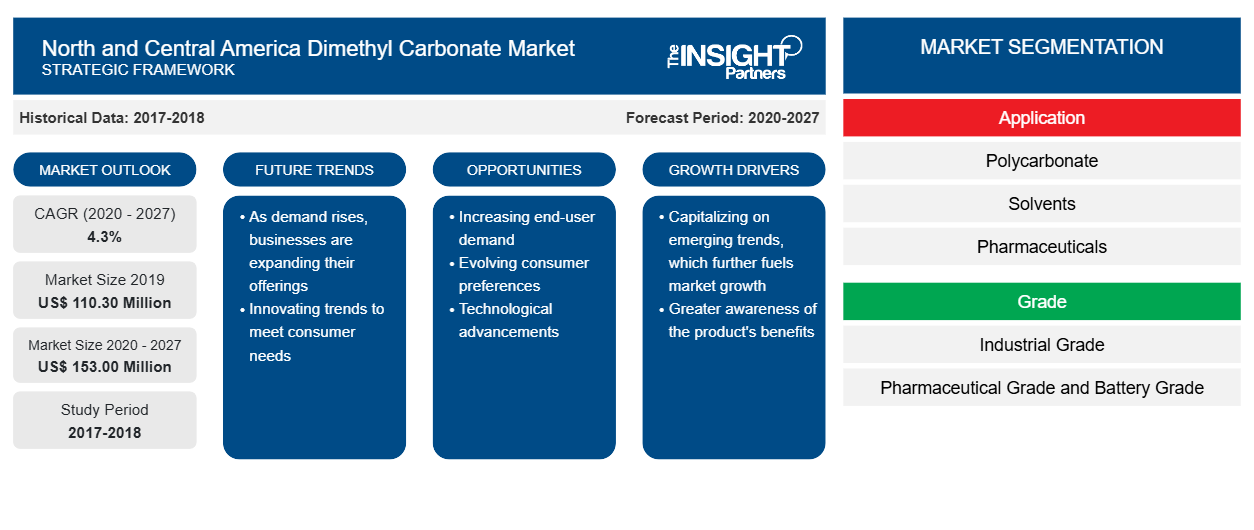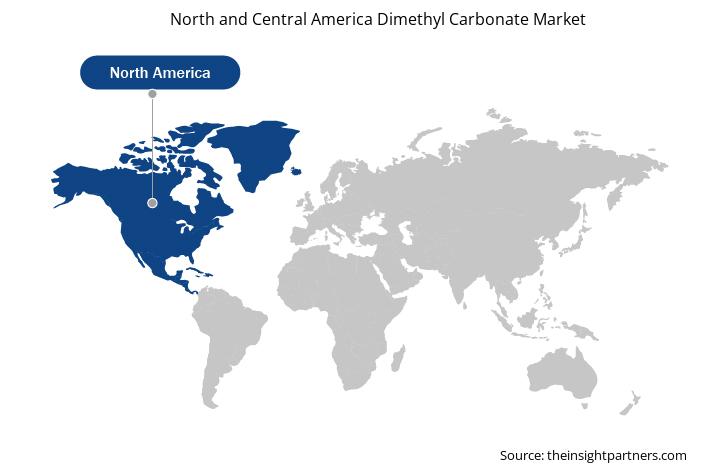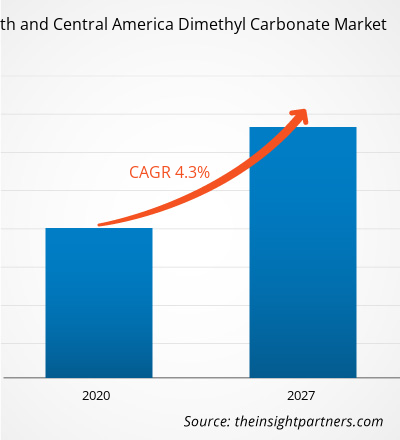The North and Central America dimethyl Carbonate was valued at US$ 110.30 million in 2019 and is projected to reach US$ 153.00 million by 2027; it is expected to grow at a CAGR of 4.3% from 2020 to 2027.
Dimethyl carbonate refers to an organic compound, which is colorless, transparent, and flammable liquid. It is usually classified as a carbonate ester. It is used as a methylating agent and a solvent that is exempt from the restrictions that is placed on most of the volatile organic compounds (VOCs) in the US. Dimethyl carbonate (DMC) is an organic compound categorized as a carbonate ester. Dimethyl carbonate has relatively mild toxicity and pleasant odor, and can be easily dissolved in organic solvents such as ester, ketone, and alcohol. Dimethyl carbonate forms an azeotrope with water, and it is non-corrosive to metals. Dimethyl carbonate is an essential component used in manufacturing polycarbonate. Polycarbonate are the types of plastics known for their high dielectric strength, impact resistance, and optical transparency. The automotive and electronics industry contributes to the high demand for polycarbonate, therefore bolstering the demand for dimethyl carbonate. Apart from the applications mentioned above, the dimethyl carbonate market is also driven by the growing demand for polycarbonate in medical devices, lighting devices, optical media, and others. DMC is considered a better alternative to traditional solvents used in paints owing to no volatile organic compounds (VOCs) emissions and no environmental impact. Besides, its solubility is similar to the mixture of solvents consisting naphtha light aromatics, making dimethyl carbonate one of the most suitable solvents for paints.
In 2019, the US was the largest market for the North and Central America dimethyl carbonate market. The dimethyl carbonate is extensively used in various industries such as plastics, paints and coatings, pharmaceuticals, batteries, and others. Dimethyl carbonate is used as a methylating agent and as a solvent that is exempt from the restrictions that are placed on most of the volatile organic compounds in the US. It is considered as a green reagent that drives the demand for dimethyl carbonate in the country. The US is taken to be one amongst the top contributors of dimethyl carbonate owing to its high consumption in the pharmaceutical industry. The government initiatives toward upgrading the public infrastructure support the market for dimethyl carbonate in the US. The growth in the construction industry post the economic downturn is expected to boost the demand for dimethyl carbonate in the near future. Further, the change in customer’s preferences toward high quality and colorful paints complements the market for dimethyl carbonate in the US.
The COVID-19 pandemic first began in Wuhan (China) during December 2019, and since then it has spread across the world at a fast pace. The US, Mexico, Canada, Panama, Costa Rica, and El Salvador are among the most affected countries in North and Central America in terms of confirmed cases and reported deaths as of October 2020. According to the latest WHO figures as of October, there are ~37,704,153 confirmed cases and 1,079,029 total deaths. COVID-19 has affected economies and industries in various countries due to lockdowns, travel bans, and business shutdowns. The North and Central America chemical and materials industry is one of the major industries suffering serious disruptions, such as supply chain breaks, disruptions in manufacturing due to COVID-19 outbreak. The lockdown of various plants and factories in China and leading regions is affecting the North and Central America supply chains and negatively impacting the manufacturing, delivery schedules, and sales of various goods. All these factors have greatly affected the North and Central America dimethyl carbonate market.
North and Central America Dimethyl Carbonate Market

- This FREE sample will include data analysis, ranging from market trends to estimates and forecasts.
Market Insights
Аррlіcations in Реѕtісіdеѕ and Рhаrmасеutісаlѕ Іnduѕtrу
Dimethyl carbonate is primarily used as a methylating agent to synthesize central nervous system drugs, analgesics, and antipyretic drugs. It is also used to manufacture methyl isocyanate, a precursor for the manufacture of carbamate pesticides in the pesticide industry. It is an eco-friendly compound that can be utilized to produce various chemicals, as a solvent. It offers multiple advantages compared to conventional organic solvents, such as ester acetates and ethers. Besides, dimethyl carbonate is often used to manufacture antibiotics in the pharmaceutical industry. Carbadox and Ciprofloxacin can be manufactured from dimethyl carbonate. Carbadox is an antibacterial agent that is used in veterinary medications. Ciprofloxacin is used to prevent certain infections caused by bacteria and is also used to avoid or treat anthrax. Besides, in the North and Central America, dimethyl carbonate is primarily used to manufacture pesticides, followed by pharmaceuticals and intermediate chemicals. Various manufacturers in the region are focusing on expanding their production capacities for dimethyl carbonate to meet the demand for dimethyl carbonate in solvents and pharmaceutical applications.
Application Insights
Based on application, the dimethyl carbonate market is segmented into polycarbonate, solvents, pharmaceuticals, battery electrolyte, and others. The polycarbonate segment led the dimethyl Carbonate market with the highest market share in 2019. Dimethyl carbonate is generally used as an intermediate in polycarbonate synthesis and produces polycarbonate by the rapidly expanding and well-established non-phosgene melt process. Polycarbonates are known for their heat resistance, structural stability, high dielectric strength, and optical transparency. In the North and Central America, dimethyl carbonate is primarily employed in the manufacture of pesticides, followed by pharmaceuticals and intermediate chemicals. Polycarbonate has become a vital environment-friendly and recyclable commercial polymer form with multiple uses in different industries such as electrical & electronics and automotive. The increasing demand for plastic products, especially polycarbonate, is expected to drive dimethyl carbonate in the North and Central America.
North and Central America Dimethyl Carbonate Market, by Application – 2019 and 2027

- This FREE sample will include data analysis, ranging from market trends to estimates and forecasts.
Grade Insights
Based on grade, the dimethyl carbonate is segmented into industry grade, pharmaceutical grade, and battery grade. The industry grade led the dimethyl carbonate market with the highest market share in 2019. Dimethyl carbonate can be used as an ideal substitute for highly toxic products such as dimethyl sulfate, phosgene, and methyl chloroformate. It can substitute solvents such as xylene, toluene, ethyl acetate, butyl acetate, acetone, or butanone in the paints and adhesive industry, and is environmentally friendly. It is an excellent hydroxymethylation agent, methylating agent, methoxylation agent, and is a kind of chemical raw material of wide application. It can also be used for synthesizing polycarbonate, diphenyl carbonate, and isocyanate, and so on. In the field of pesticides, DMC can be primarily used to produce methyl isocyanate, thus producing some carbamate drugs, pesticides (anisole). Also, dimethyl carbonate can be used as gasoline additives and lithium battery electrolytes, and so on. Dimethyl carbonate (DMC) reacts with acids to liberate heat along with carbon dioxide and methanol. The growing demand for polycarbonates from different industries, including electrical & electronics and automotive, is expected to bolster the industry-grade segment's growth, increasing the development of the dimethyl carbonate market.
End Use Industry Insights
Based on end use industry, the dimethyl carbonate is segmented into plastics, paints & coatings, pharmaceuticals, batteries, and others. The plastics segment led the dimethyl carbonate market with the highest market share in 2019. Dimethyl carbonate is a colorless and flammable organic compound. The high dielectric constant and low vapor pressure of dimethyl carbonate makes it suitable to be used as a plasticizer for the purpose of enhancing the ionic conductivity of methyl cellulose-based solid polymer electrolyte. Dimethyl carbonate acts as a methylating or methoxycarbonylating agent used for the transformation of small bio-based molecules and the synthesis of biopolymers. It is also used in the preparation of films. Various amounts of dimethyl carbonate solutions are mixed with other polymers to obtain plastic films. Polycarbonate refers to an incredibly useful plastic for various applications that require high impact resistance and transparency. It serves as a lighter alternative to glass or natural UV filters. Dimethyl carbonate is often used in the synthesis of polyCarbonate. A green synthetic strategy of bio-based (isosorbide carbonate) PIC from dimethyl carbonate and renewable isosorbide (ISB) has been developed by employing organo-catalysts. This avoids the use of toxic metals and chemicals.
North and Central America Dimethyl Carbonate Market, by Application– 2019 & 2027
Customize This Report To Suit Your Requirement
You will get customization on any report - free of charge - including parts of this report, or country-level analysis, Excel Data pack, as well as avail great offers and discounts for start-ups & universities
North and Central America Dimethyl Carbonate Market: Strategic Insights

- Get Top Key Market Trends of this report.This FREE sample will include data analysis, ranging from market trends to estimates and forecasts.
You will get customization on any report - free of charge - including parts of this report, or country-level analysis, Excel Data pack, as well as avail great offers and discounts for start-ups & universities
North and Central America Dimethyl Carbonate Market: Strategic Insights

- Get Top Key Market Trends of this report.This FREE sample will include data analysis, ranging from market trends to estimates and forecasts.
Alfa Aesar, Hebei New Chaoyang Chemcial Stock Co. Ltd., Kowa American Corporation, Merck KGaA, and Ube Industries Ltd. are among the key players present in the North and Central America dimethyl carbonate market. These companies are implementing new product development and mergers and acquisition strategies to enlarge the customer base and gain significant market share across the world, which, in turn permit the players to maintain their brand name.
North and Central America Dimethyl Carbonate Market, byApplication
- Polycarbonate
- Solvents
- Pharmaceuticals
- Battery Electrolyte
- Others
North and Central America Dimethyl Carbonate Market, by Grade
- Industry Grade
- Pharmaceuticals Grade
- Battery Grade
North and Central America Dimethyl Carbonate Market, by End Use Industry
- Plastics
- Paints & Coatings
- Pharmaceuticals
- Batteries
- Others
Company Profiles
- Alfa Aesar
- Hebei New Chaoyang Chemcial Stock Co. Ltd.
- Kowa American Corporation
- Merck KGaA
- Ube Industries Ltd.
North and Central America Dimethyl Carbonate Market Regional Insights
The regional trends and factors influencing the North and Central America Dimethyl Carbonate Market throughout the forecast period have been thoroughly explained by the analysts at Insight Partners. This section also discusses North and Central America Dimethyl Carbonate Market segments and geography across North America, Europe, Asia Pacific, Middle East and Africa, and South and Central America.

- Get the Regional Specific Data for North and Central America Dimethyl Carbonate Market
North and Central America Dimethyl Carbonate Market Report Scope
| Report Attribute | Details |
|---|---|
| Market size in 2019 | US$ 110.30 Million |
| Market Size by 2027 | US$ 153.00 Million |
| Global CAGR (2020 - 2027) | 4.3% |
| Historical Data | 2017-2018 |
| Forecast period | 2020-2027 |
| Segments Covered |
By Application
|
| Regions and Countries Covered | North America
|
| Market leaders and key company profiles |
North and Central America Dimethyl Carbonate Market Players Density: Understanding Its Impact on Business Dynamics
The North and Central America Dimethyl Carbonate Market is growing rapidly, driven by increasing end-user demand due to factors such as evolving consumer preferences, technological advancements, and greater awareness of the product's benefits. As demand rises, businesses are expanding their offerings, innovating to meet consumer needs, and capitalizing on emerging trends, which further fuels market growth.
Market players density refers to the distribution of firms or companies operating within a particular market or industry. It indicates how many competitors (market players) are present in a given market space relative to its size or total market value.
Major Companies operating in the North and Central America Dimethyl Carbonate Market are:
- Alfa Aesar
- Hebei New Chaoyang Chemcial Stock Co. Ltd.
- Kowa American Corporation
- Merck KGaA
- Ube Industries Ltd.
Disclaimer: The companies listed above are not ranked in any particular order.

- Get the North and Central America Dimethyl Carbonate Market top key players overview
- Historical Analysis (2 Years), Base Year, Forecast (7 Years) with CAGR
- PEST and SWOT Analysis
- Market Size Value / Volume - Global, Regional, Country
- Industry and Competitive Landscape
- Excel Dataset
Testimonials
Reason to Buy
- Informed Decision-Making
- Understanding Market Dynamics
- Competitive Analysis
- Identifying Emerging Markets
- Customer Insights
- Market Forecasts
- Risk Mitigation
- Boosting Operational Efficiency
- Strategic Planning
- Investment Justification
- Tracking Industry Innovations
- Aligning with Regulatory Trends
Yes! We provide a free sample of the report, which includes Report Scope (Table of Contents), report structure, and selected insights to help you assess the value of the full report. Please click on the "Download Sample" button or contact us to receive your copy.
Absolutely — analyst assistance is part of the package. You can connect with our analyst post-purchase to clarify report insights, methodology or discuss how the findings apply to your business needs.
Once your order is successfully placed, you will receive a confirmation email along with your invoice.
• For published reports: You’ll receive access to the report within 4–6 working hours via a secured email sent to your email.
• For upcoming reports: Your order will be recorded as a pre-booking. Our team will share the estimated release date and keep you informed of any updates. As soon as the report is published, it will be delivered to your registered email.
We offer customization options to align the report with your specific objectives. Whether you need deeper insights into a particular region, industry segment, competitor analysis, or data cut, our research team can tailor the report accordingly. Please share your requirements with us, and we’ll be happy to provide a customized proposal or scope.
The report is available in either PDF format or as an Excel dataset, depending on the license you choose.
The PDF version provides the full analysis and visuals in a ready-to-read format. The Excel dataset includes all underlying data tables for easy manipulation and further analysis.
Please review the license options at checkout or contact us to confirm which formats are included with your purchase.
Our payment process is fully secure and PCI-DSS compliant.
We use trusted and encrypted payment gateways to ensure that all transactions are protected with industry-standard SSL encryption. Your payment details are never stored on our servers and are handled securely by certified third-party processors.
You can make your purchase with confidence, knowing your personal and financial information is safe with us.
Yes, we do offer special pricing for bulk purchases.
If you're interested in purchasing multiple reports, we’re happy to provide a customized bundle offer or volume-based discount tailored to your needs. Please contact our sales team with the list of reports you’re considering, and we’ll share a personalized quote.
Yes, absolutely.
Our team is available to help you make an informed decision. Whether you have questions about the report’s scope, methodology, customization options, or which license suits you best, we’re here to assist. Please reach out to us at sales@theinsightpartners.com, and one of our representatives will get in touch promptly.
Yes, a billing invoice will be automatically generated and sent to your registered email upon successful completion of your purchase.
If you need the invoice in a specific format or require additional details (such as company name, GST, or VAT information), feel free to contact us, and we’ll be happy to assist.
Yes, certainly.
If you encounter any difficulties accessing or receiving your report, our support team is ready to assist you. Simply reach out to us via email or live chat with your order information, and we’ll ensure the issue is resolved quickly so you can access your report without interruption.















The List of Companies - North and Central America Dimethyl Carbonate Market
- Alfa Aesar
- Hebei New Chaoyang Chemcial Stock Co. Ltd.
- Kowa American Corporation
- Merck KGaA
- Ube Industries Ltd.






 Get Free Sample For
Get Free Sample For